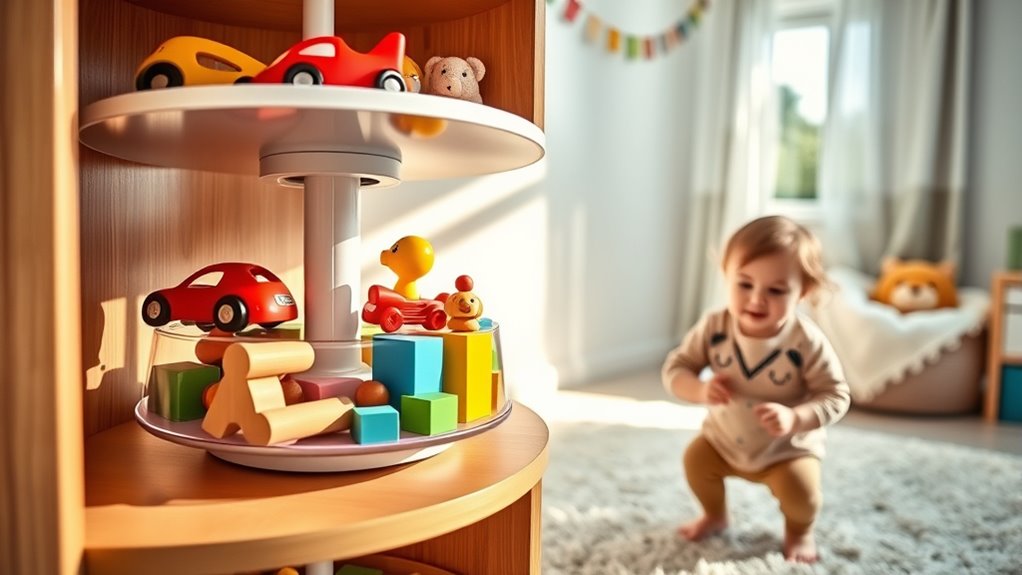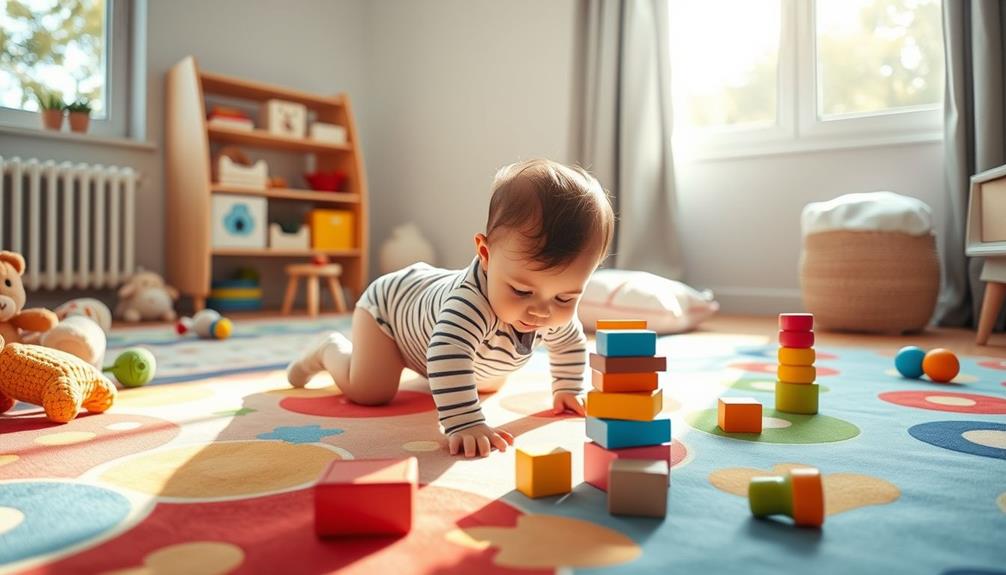Rotating toys is a simple trick to manage clutter while keeping your toddler engaged. By swapping out a few toys regularly, you tap into their natural curiosity and renew their interest in play. It also encourages exploration, sensory development, and responsibility as they learn to care for their toys. Plus, a well-organized space reduces overwhelm for both of you. Keep going, and you’ll discover even more ways to create a fun, clutter-free play environment.
Key Takeaways
- Rotating toys maintains toddler interest by providing fresh, engaging options and preventing boredom.
- Organized storage solutions make swapping toys simple, reducing clutter and encouraging tidy habits.
- Regularly changing toys introduces new textures and sounds, boosting sensory development and exploration.
- Limited toy access teaches responsibility, respect, and makes clean-up a fun, educational activity.
- A well-implemented rotation creates an organized, calming play space that supports learning and minimizes stress.

Have you ever wondered why rotating toys capture kids’ attention so effectively? It’s because they tap into your toddler’s natural curiosity and love for discovery. By switching out toys regularly, you keep their environment fresh and exciting, preventing boredom and reducing clutter. One of the best ways to do this is through smart storage solutions that make rotating toys simple and organized. When toys are easy to access and put away, you’re more likely to maintain a clutter-free space, which is essential for a calm, safe play area. Using bins, shelves, or baskets that are clearly labeled or color-coded helps your child learn to put toys away and find new ones effortlessly. This organized approach also makes it easier for you to swap out toys regularly, ensuring your toddler always has something new to explore.
Rotating toys isn’t just about decluttering; it’s also a fantastic way to enhance sensory play. Sensory play involves activities that stimulate your child’s senses—touch, sight, sound, and even smell—helping develop their cognitive and motor skills. When you rotate different toys, you introduce your child to a variety of textures, shapes, and sounds, enriching their sensory experience. For example, one week, you might keep out a set of textured blocks, and the next, a musical instrument or a set of colorful, reflective toys. This variation keeps their sensory pathways active and engaged, encouraging exploration and learning. It’s important to select toys that promote sensory play, such as soft fabrics, bumpy textures, or toys that make different sounds, to maximize the benefits of rotation.
Incorporating a rotation system also encourages your toddler to take responsibility for their toys. When they understand that certain toys are only available for a limited time, they tend to treat their toys with more care and respect. Plus, the anticipation of discovering “new” toys can turn clean-up time into a fun game rather than a chore. This approach helps instill good habits early on, like tidying up and appreciating different types of play. Remember, the goal isn’t just to keep the space tidy but to create an environment that fosters curiosity, learning, and sensory development. With thoughtful storage solutions and a consistent rotation schedule, you’ll find that your toddler remains engaged, entertained, and less overwhelmed by clutter. It’s a simple trick that makes a big difference in your daily routine and your child’s growth.
Frequently Asked Questions
How Often Should I Rotate My Child’s Toys?
You should rotate your child’s toys every 1 to 2 weeks to keep their interest high and reduce clutter. This is a smart parental strategy that promotes toy organization and prevents overwhelm. By swapping out toys regularly, you give your toddler new challenges and surprises, encouraging development and engagement. Keep a few favorites accessible while storing others away, then switch them periodically to maintain a fresh and stimulating play environment.
Are There Safety Concerns With Rotating Toys?
Did you know that toy safety remains a top concern for parents, with choking hazards accounting for many injuries? When rotating toys, you should check for small parts or broken pieces that could pose risks. Always supervise playtime and make sure toys meet safety standards. Regularly inspect toys for wear and tear, and keep choking hazards out of reach. Properly rotating toys can keep your child safe while keeping playtime fun.
Can Rotating Toys Help With Developmental Milestones?
Rotating toys can definitely help with your toddler’s developmental milestones. By introducing toy diversity, you expose them to new shapes, colors, and textures, which boosts their cognitive skills. Plus, sensory stimulation from different toys encourages their fine and gross motor development. Regularly switching toys keeps your child engaged and curious, supporting their overall growth. So, rotating toys isn’t just clutter control—it’s a smart way to nurture your toddler’s development.
What Types of Toys Are Best for Rotation?
Think of toy rotation as a well-curated gallery. You want a mix of classic favorites, educational toys, and sensory items. Focus on toy categorization to keep things organized, making storage solutions easier. Rotate different types weekly so your toddler stays engaged and challenged. Avoid overcrowding by storing extras out of sight. This keeps play fresh, stimulates development, and prevents toy boredom—making playtime both fun and manageable.
How Do I Store Toys During Rotation Periods?
To store toys during rotation periods, focus on effective toy organization and storage solutions. Use clear bins or baskets labeled by type or activity, making it easy to swap toys in and out. Consider a dedicated storage area like a closet or under-bed storage to keep unused toys out of sight. Regularly tidy and rotate toys to maintain a clutter-free space, ensuring your toddler stays engaged with fresh options.
Conclusion
By rotating toys, you’re opening a magical door to endless adventures for your toddler. It’s like planting a garden of curiosity, where each new toy blooms with excitement and discovery. This simple trick keeps their world fresh and vibrant, preventing boredom from sneaking in like a silent thief. As you weave this enchanting routine, you’re nurturing their imagination and creating a clutter-free haven where joy blooms endlessly. Your thoughtful approach turns everyday moments into treasured memories.










